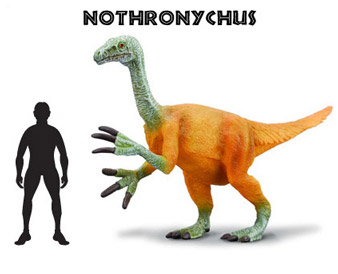Planet Dinosaur – A New Cast of Characters Nothronychus
The Bizarre Theropod Nothronychus
In the final episode of the six-part television series “Planet Dinosaur”, the programme focuses on how the Dinosauria adapted and evolved to exploit new environmental opportunities. The theropods, arguably the most successful of the main groups of dinosaurs, are featured heavily with oviraptorids and tyrannosaurs. In addition, for the first time in this television series, viewers are introduced to the “Scythe Lizards”, the spectacular therizinosaurs and the best known genus of therizinosaur – Nothronychus makes an appearance.
Nothronychus
Nothronychus is a member of the therizinosaurid (pronounced Ther-ih-zine-oh-sore-id) family, a bizarre group related to meat-eating dinosaurs, but adapted to eating plants. Nothronychus was the first therizinosaur to be found outside Asia. It has the typical features of a therizinosaur, a small head, with jaws that contained leaf-shaped teeth, (suggesting a plant-eating diet) and a beak. The long neck was used to reach up into the branches of trees so that Nothronychus could feed. The strong, powerful arms with their three-clawed hands are typical of the therizinosaur group.
Scientists believe that this type of dinosaur would have had a similar lifestyle to the extinct giant sloth (Megatherium) and this is how Nothronychus (sloth-like claw) got its name. Nothronychus was named and described by James Kirkland and Douglas Wolfe in 2001. It is known from two partial skeletons, approximately 40-50% complete. The species name is Nothronychus graffami. Everything Dinosaur team members have posted up a picture of a Nothronychus dinosaur model.
An Illustration of Nothronychus graffami
Picture credit: Everything Dinosaur
Dinosaur Models and Replicas
To view dinosaur models including therizinosaurs, take a look at the huge range of prehistoric animal figures stocked by Everything Dinosaur: Prehistoric Animal Models and Figures.
The discovery of this five-metre-long giant was a curious as this dinosaur’s anatomy. Barry Albright of the University of North Florida and David Gillette (Museum of Northern Arizona) were exploring some Cretaceous marine deposits for vertebrate fossils in an area of western Utah (USA) when Merle Graffam, a museum volunteer who was with them found a dinosaur toe bone.
The site was carefully examined and it was thought that more of the dinosaur’s fossils were in the strata waiting to be exposed by the elements. An excavation was started and by its end, the team had recovered nearly half the skeleton of a new North American theropod, a therizinosaur, the first to be discovered outside Asia.
It seems peculiar to find the fossilised remains of a terrestrial animal more than sixty miles out from the prehistoric shore line in what are marine deposits. How did the Nothronychus get there? A number of theories have been put forward, perhaps this animal was washed out to sea and drowned and currents took the carcase to its final resting place. Or maybe the corpse of this bizarre theropod was taken out to sea by a receding flood tide.
One of the puzzles is, with an ocean full of hungry predators the carcase was not scavenged and torn apart. The body was very nearly complete when it settled on the seabed. Some scientists have postulated that this plant-eater was carried far out to sea on a huge floating mat of soil and vegetation and eventually drowned when the raft broke up.



